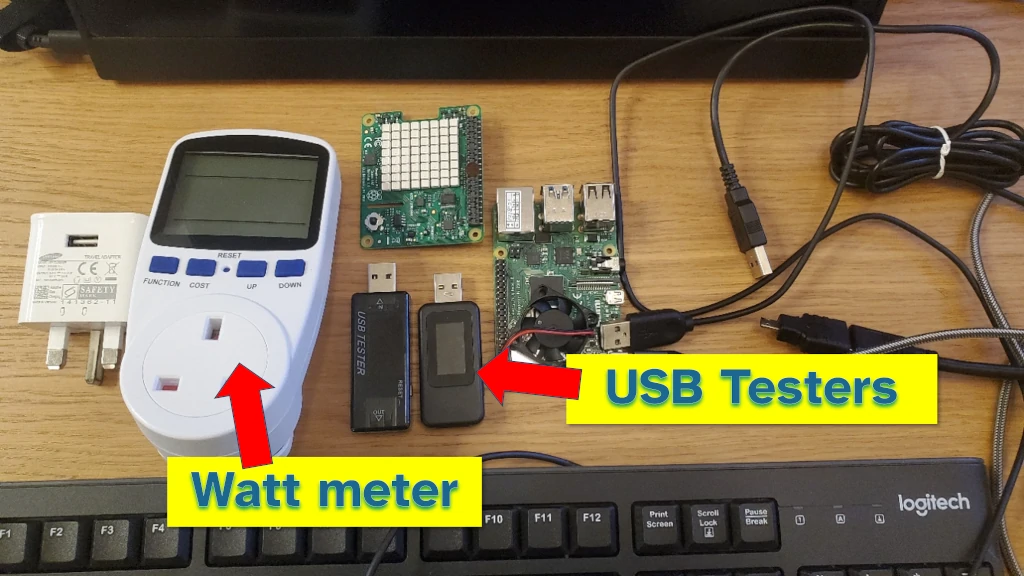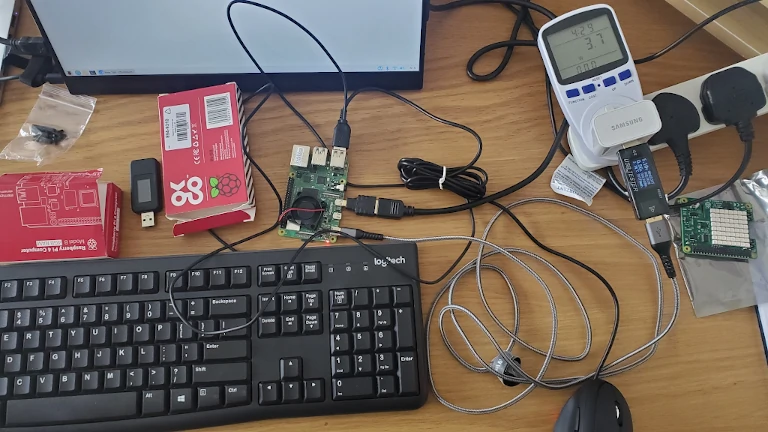I wanted to know how much it costs to run my Raspberry Pi 4 if I left it running for a day, a week, a month, and even a year. To figure this out, I conducted over 30 measurements of how much power my Raspberry Pi used running various tasks, and calculated how much it would cost to run. I used a price of 16 cents per kilowatt-hour as taken from this source.
A Raspberry Pi costs between 1.1 cents and 2.3 cents per day to run. This is equivalent to between $3.65 and $8.57 per year. The more expensive costs occur when the Raspberry Pi is running multiple apps intensively, such as busy web server. Reducing the amount of work the Raspberry Pi is the best way to reduce electricity costs.
I tested the amount of power a Raspberry Pi used when it was idle, running an intense load, and with various peripherals and wireless communications in use. A summary of these measurements, represented as costs based on $0.16/kWh is described in the table below:
| Period | Cost (light load) | Cost (heavy load) |
|---|---|---|
| Daily | $0.02 | $0.01 |
| Weekly | $0.07 | $0.16 |
| Monthly | $0.30 | $0.71 |
| Yearly | $3.65 | $8.57 |
If you’re interested in the full test results, I posted them here: chipwired.com/raspberry-pi-power-use

In this guide I’ve explored how much this cost changes by using different configurations of Raspberry Pi (e.g. Sense HAT, keyboard and mouse, etc.). I also looked at how to reduce the costs of running a Raspberry Pi.
How much does it cost to use the Sense HAT?
I used the official Sense HAT when conducting these tests. This allowed me to see how much power a Raspberry Pi would draw if it was reading sensors or using an LED display. It didn’t use much.
Adding a Sense HAT to a Raspberry Pi increases the cost by 0.3 cents per day, or $1.10 per year, based on an electricity cost of 20 cents per kilowatt hour. This is due to the Sense HAT adding approximately 300mW of power to the requirements of a Raspberry Pi.

A Sense HAT is relatively cheap to run, which makes it handy for data collection projects – if you’re Raspberry Pi is running 24/7 to collect data, you don’t want the sensors themselves to be adding much to the cost. I wrote a whole guide to data collection with Raspberry Pi, check it out here: chipwired.com/collect-data-with-raspberry-pi
How much does it cost to have keyboard and mouse plugged in?
I also tested the power use of the Raspberry Pi when peripherals such as a keyboard and mouse were plugged in. Running a Raspberry Pi in headless mode (i.e. without monitor, keyboard, and mouse) is a good way to save power, so I wanted to understand what the impact of these were.
Adding a keyboard and mouse to a Raspberry Pi increases the cost by 0.1 cents per day, or 37 cents per year, based on an electricity cost of 20 cents per kilowatt hour. Even when not in use, a connected keyboard and mouse will draw electricity which adds to the cost of running the Raspberry Pi.
It doesn’t cost much to add a keyboard and mouse to a Raspberry Pi. If you want to replace your desktop with a Raspberry Pi (an option I’m exploring as part of my mission to simplify tech and unleash the power of small computers), it won’t cost you much to add on a keyboard and mouse.
How to reduce the costs of running a Raspberry Pi
Some of the ways to reduce the costs of running a Raspberry Pi include:
- Using a Raspberry Pi Zero or Pico instead of a 3 or 4 (these use less power)
- Turning off the USB and Ethernet peripherals
- Throttling the CPU (slowing it down)
- Turning off WiFi and Bluetooth
- Turning off HDMI
- Turning off the ACT LED (small gain)
These savings can shave roughly 50 cents to $1 off the annual running cost of a Raspberry Pi. I also found it hard to actually implement the above list of power savings. If you really need to save power, consider switching to a Zero, Pico, or even an Arduino instead.
I used the Raspberry Pi 4 for all my experiments and calculations. This is a little more power hungry than the Zero or the Pico. I reckon you could have your electricity bill for Raspberry Pi by switching to a Zero or Pico instead.
Stopping apps from running and reducing the CPU load is also a good way to reduce the amount of power the Raspberry Pi uses. I wrote a guide to stopping apps running on a Pi, check it out here: chipwired.com/stop-program-raspberry-pi
Is it expensive to use Raspberry Pi?
For typical uses such as data collection, or replacing your desktop computer, it is not expensive to run a Raspberry Pi. It costs between $4 and $9 per year to run a Raspberry Pi as a desktop computer, while a regular desktop costs between $9 and $37 (source from here – all calculations assume 24/7 operation).
| Period | Raspberry Pi (full load) | Desktop PC (full load) |
|---|---|---|
| Daily | $0.02 | $0.10 |
| Weekly | $0.17 | $0.72 |
| Monthly | $0.75 | $3.13 |
| Yearly | $9.00 | $37.54 |
The above table assumes a full load as you would use the computer for browsing the web and getting work done.
While running a desktop PC isn’t exactly expensive, it is still a lot cheaper to run a Raspberry Pi instead. This is because the Raspberry Pi has a slower CPU and less peripherals (e.g. graphics card) that it needs to power.
Saving power is one of the reasons to replace your desktop PC with a Raspberry Pi, it also helps you simplify the technology you use (a theme I’m currently exploring).
Bottom Line
A Raspberry Pi is cheap to run as it doesn’t use much electricity. For typical use as a full computer, it costs about $8-$9 to run. If the aim is to save power, such as when using it for remote data collection, this cost can drop as low as $3.65. This is far cheaper than a desktop PC.
The easiest way to reduce the power requirement of a Raspberry Pi is to make sure you’re using the right model of Pi for the job. A Zero or a Pico use far less power than a Raspberry Pi 3 or 4.
While I ran this experiment myself, if you’re interested in some of the references and comparisons I used, check out the links below:
